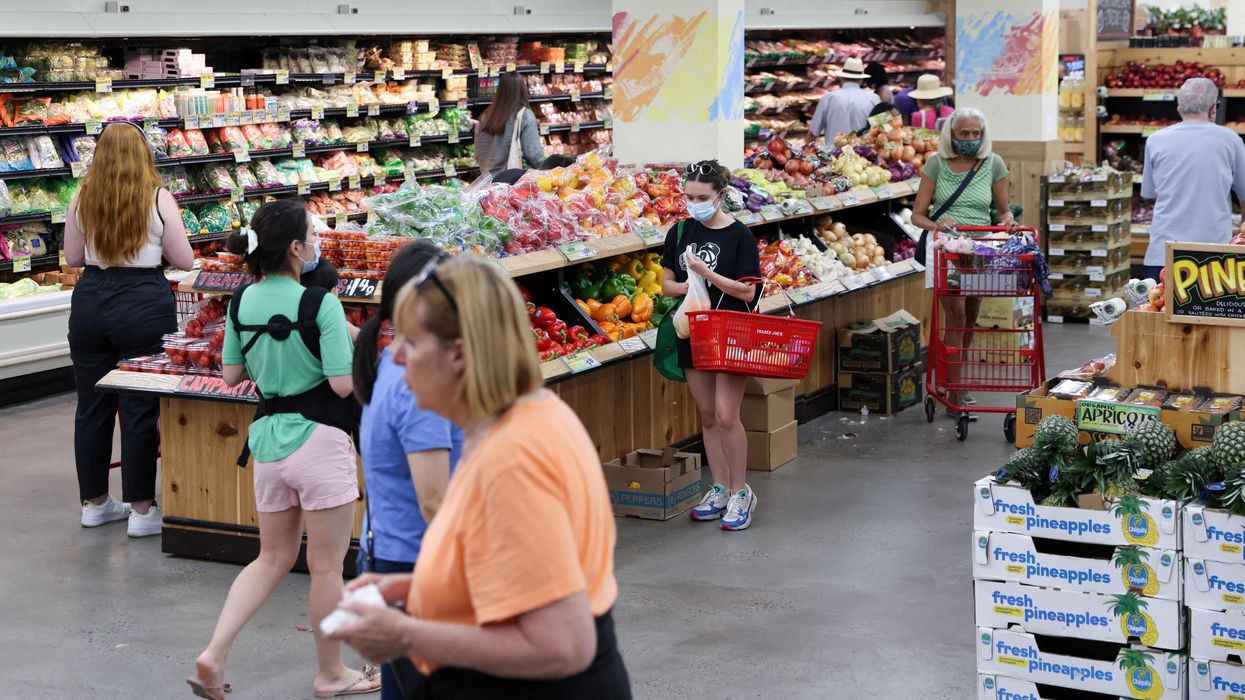The Current, delivered daily.
WASHINGTON (Reuters) - U.S. retail sales unexpectedly fell in May as motor vehicle purchases declined amid rampant shortages, and record high gasoline prices pulled spending away from other goods.
The first drop in sales in five months reported by the Commerce Department on Wednesday also suggested that high inflation was starting to hurt demand. It followed in the wake of major retailers like Walmart and Target cutting their profit forecasts because of cost pressures.
Still, the weak retail sales will not divert the Federal Reserve from its aggressive monetary policy tightening path to bring inflation back to its 2% target. The U.S. central bank is expected to raise its policy interest rate later on Wednesday for a third time this year, with an increase of 3/4 of a percentage point seen as likely.
"While high personal savings and strong job and wage growth help, consumers are facing stiff headwinds from four-decade high inflation, rapidly rising borrowing costs, and the bear market in equities," said Sal Guatieri, a senior economist at BMO Capital Markets in Toronto.
"The Fed will need to see a sustained period of weakness in domestic demand and likely labor markets before breathing a sigh of relief on the inflation front."
Retail sales dropped 0.3% last month. Data for April was revised lower to show sales increasing 0.7% instead of 0.9% as previously reported. Economists polled by Reuters had forecast retail sales gaining 0.2%, with estimates ranging from as low as a 1.1% decline to as high as a 0.5% increase.
Retail sales are mostly goods, and are not adjusted for inflation. Sales rose 8.1% on a year-on-year basis and are well above their pre-pandemic trends, supported by massive savings and rising wages from a tight labor market.
The decline in monthly retail sales was led by receipts at auto dealerships, which dropped 3.5%, the largest fall in nearly a year, after increasing 1.8% in April. China's zero COVID-19 policy has exacerbated a global semiconductor shortage.
Online store sales fell 1.0%. There were declines in sales at electronics and appliance retailers as well as furniture stores. But sales at building material, garden equipment and supplies stores gained 0.2%. Receipts at sporting goods, hobby, musical instrument and book stores increased 0.4%. Clothing store sales edged up 0.1%.
Sales at services stations surged 4.0%, driven by record high gasoline prices. The national average price of gasoline jumped to an all-time high of $4.439 per gallon in May, according to data from the U.S. Energy Information Administration. Prices at the pump are now about $5 per gallon.
Excluding gasoline, retail sales dropped 0.7%. Food and beverage stores sales increased 1.2%. The National Retail Federation said the weak sales underscored the need for the White House to repeal tariffs on Chinese goods.
"Retail sales are reflecting Americans' growing concern about inflation," NRF president Matthew Shay said. "Retailers are doing what they can to keep prices down, but we continue our call on the administration to repeal unnecessary and costly tariffs on goods from China to relieve pressure on consumers."
The economy's waning fortunes were also highlighted by a separate report from the New York Fed showing manufacturing activity in New York state remained weak in June, with order backlogs declining for the first time in over a year.
Confidence among single-family homebuilders dropped to a two-year low this month, a third report showed.
Stocks on Wall Street were higher. The dollar fell against a basket of currencies. U.S. Treasury prices rose.
Services back in vogue
The decline in retail sales also reflected a gradual rotation of spending from goods to services. Receipts at bars and restaurants, the only services category in the retail sales report, increased 0.7% last month.
"It's possible consumers reached a saturation point for goods spending and are now shifting towards higher leisure spending heading into the summer months," said Will Compernolle, a senior economist at FHN Financial in New York.
Excluding automobiles, gasoline, building materials and food services, retail sales were unchanged in May. Data for April was revised down to show these so-called core retail sales increasing 0.5% instead of 1.0% as previously reported.
Core retail sales correspond most closely with the consumer spending component of gross domestic product. While consumers are spending more on services, May's weak retail sales and the downward revisions to April data suggested consumption was slowing in the second quarter. Retail sales account for about a third of consumer spending.
JPMorgan slashed its second-quarter GDP estimate to a 2.5%annualized rate from a 3.25% pace. The economy contracted at a 1.5% rate in the first quarter. Citigroup, however, cautioned that retail sales were likely overstating the degree of slowdown in consumption.
"Total consumption data released at the end of the month will likely continue to show that some of the slowing in goods spending reflects a shift back towards services spending," said Veronica Clark, an economist at Citigroup in New York.
(Reporting by Lucia Mutikani; Editing by Chizu Nomiyama)
Trending in Economy
Macy's sees 'reset year' for ecommerce
The retailer's marketplace is expanding quickly.
When it comes to ecommerce growth, was the pandemic a blip or a new trendsetter?
As we move further from the height of COVID-related closures, it’s a question that will start to be answered through the lens of history.
So far, the narrative of ecommerce growth in the U.S. from 2019-2022 has gone like this: Ecommerce’s share of overall retail saw a huge spike at the height of the pandemic in 2020-21, when goods in general were in demand and online shopping was necessary to preserve health and safety. Experts looked out and saw a permanent exponential change in the penetration of ecommerce as a share of retail that would last beyond the pandemic. Then, in 2022, everyone went back to stores and the trendline came back to 2019 levels. Growth was no longer exponential. There was still growth, but it was not happening as fast as during the pandemic period.
With this in mind, it’s worth pointing out that 2023 is the first year that there likely won’t be a pandemic-influenced swing to influence ecommerce growth. It is also a year where demand has suffered challenges amid inflation and interest rate hikes.
So as we seek to determine the importance of ecommerce to overall retail, it’s worth it to continue taking a close look at what growth trends retailers are seeing now, whether ecommerce is remaining resilient amid consumer pullback and how retailers are preparing for the future.
The latest example arrived this week from Macy’s. It’s a fitting one for the times. Overall, Macy’s is seeing a slowdown as consumers pull back on discretionary purchases, with sales declining 7% in the first quarter versus the same quarter of 2022. Digital sales were down 8%.
Macy’s is particularly susceptible to the macroeconomic headwinds that many brands and retailers are facing, as spending among the middle-income consumers it counts as a primary customer base is particularly softening, said GlobalData Managing Director Neil Saunders.
But while ecommerce is slowing overall, the importance it gained to Macy’s business during the pandemic is remaining in place.
In 2019, ecommerce made up 25% of Macy’s revenue, CEO Jeff Gennette told analysts on the company’s earnings call. That jumped to a high of 44% in 2020. By 2022, digital reached 33% of sales after the pandemic boom. In the first quarter of 2023, it remained at 33%. So, while the trend line dipped after shoppers returned to stores, ecommerce share still settled in at a higher post-lockdown point than it was before the pandemic.
This came in a quarter in which traffic was “relatively good” across both online and in-store, Gennette said. It was “flattish” online, and slightly up in stores.
“We do expect that this is the reset year with the penetration between them,” Gennette said. “But we do expect more aggressive growth in digital in the future versus stores as we think about '24 and beyond. And that's going to be foisted by a lot of ideas and strategies.
Over the last year, the retailer has made investments in boosting ecommerce, even as shoppers returned to stores. In a bid to boost the assortment of goods available online, Macy’s launched a marketplace in September 2022 that welcomes goods from third-party sellers.
The marketplace had an “outstanding” first quarter, said Macy’s President Tony Spring, who is poised to succeed Gennette as CEO next year. Gross merchandise value increased over 50% when compared to the fourth quarter of 2022, while the average order value and units per order for marketplace customers was 50% above those not shopping at the marketplace.
Macy’s is continuing to build the marketplace even as it racks up sales. The retailer added 450 brands, ending the quarter with 950 brands.
This is helping to draw in new customers, as well as younger existing customers who are buying more items, resulting in increased basket size.
“We're very excited as to how marketplace is really attracting the Gen Z customer, particularly in categories where it was not economically feasible for us to carry in the past,” Gennette said.
In the end, Gennette said a strong digital and social presence is key to attracting younger consumers. That's a different type of shopper than other age groups.
“We know the younger customer starts first online,” Gennette said. That behavior will still be in place as the generation gets older, and gains more buying power in the process.
Going forward, Macy’s is seeking to expand the model to other retail banners in its portfolio. Bloomingdale’s will open a marketplace in the early fall.
The Macy’s ecommerce trajectory isn’t that different from the wider U.S. ecommerce narrative detailed above. With one quarter of 2023 data, there is evidence that ecommerce share settled out at a higher point after the pandemic than where it started before COVID arrived. There is flattening now, but the retailer is taking it not as a sign of a slowdown, or a signal to change course. Rather, it sees changing consumer behavior as a reason to build for the future.










